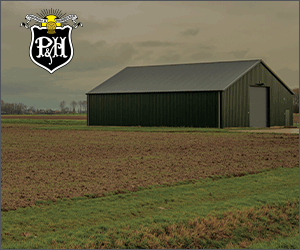Cropside: Frosted wheat?!
AGRONOMIC INFORMATION FROM ONTARIO'S CROP SPECIALISTS

TIMING IS EVERYTHING! In 2012, repeated hard frosts, down to -7C and colder throughout April had me scrambling, looking at field after field for frozen wheat. The research suggested that -4C for two hours could cause damage. Tremendous leaf injury showed up time and again, but head damage? I found only one field: on black muck soil in Hay Swamp that was already stressed with manganese deficiency. Fast forward to 2013: May 24, -2.5C for just four hours. But the wheat was in boot stage, and -2C for two hours is all it takes to cause injury. The result: some frost prone advanced fields on sand were 85% killed, and the whole field had to be replanted. Other fields had injury to individual heads, scattered throughout the field, sometimes less than 1% of the heads, sometimes up to 10%.
PHOTO: Frozen field with sand knolls completed sterile and lower areas virtually untouched. Field replanted.

PHOTO: Heads emerging white and sterile with virtually no leaf injury at all. Stems not killed, or heads would not emerge. Very specific temperature, only pollen and ovule affected.

PHOTO: completely frozen heads.

The findings: sharp sand knolls had more injury than lower areas with blacker soil (weird, eh?). The drier the region was (some areas had received no rainfall for all of May) the more frost injury there was. The earlier the wheat was planted, the more injury the frost caused (this makes sense: earlier planted wheat would be further advanced, and thus more susceptible to freeze injury). There was little rhyme or reason to which head seemed to show injury in fields with sporadic heads, or which part of the head showed the injury: microclimates in the canopy, splitting of the boot, exact stage of the crop must all be involved. Lots of “kinked” heads resulted, and although the most calls I received were about this, it has almost no yield impact. The other symptoms resulted in total yield loss of that part of the field/head.
PHOTO: Sporadic heads with frost injury. Left head was merely “snagged” and pollination unaffected. Other heads various amount of injury, not in any consistent pattern or stage of development.

There are almost no management options to avoid this type of injury. While later planted wheat was unaffected, later planted wheat also has less yield potential. It doesn’t make much sense to plant later and “lock in” lower yields when the chance of this injury is very slight. In 28 years of being the wheat specialist for Ontario, this is the worst frost injury by orders of magnitude. And it was extremely close: another degree colder could have wiped out a significant amount of the wheat in the province. Let’s hope it doesn’t happen again for another 28 (or more) years! •






















